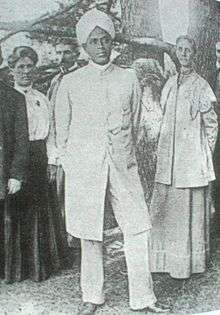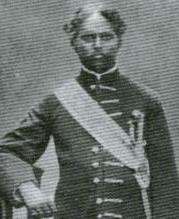Ceylonese Mudaliyars
Mudali (or Mudaliyar) was a colonial title and office in Ceylon (now Sri Lanka). The Portuguese colonials created the Mudaliyar class in the 17th century by enlisting natives of different castes form the coastal areas, who were most likely to serve the Portuguese masters with utmost loyalty. The Dutch continued the practice of the Portuguese. This class used the Mudali as a hereditary title; however, the British re-established a Mudaliyar class, with appointments that had the title of Mudali, this process was stopped in the 1930s when the Native Department of the British government of Ceylon was closed down. All Official and Titular appointments of Mudaliyars were made by the Governor of Ceylon. Appointments were non-transferable and usually hereditary, made to locals from wealthy influential families loyal the British Crown.
History
Mudaliyar is a South Indian and Tamil name for ‘first’ and a person endowed with wealth. The position was created in the 17th century by the Portuguese to function as a link between the colonial administration and the local populace, as they had done in South India. Incumbents received payment in form of land grants and use of tenured service (Rajakariya) of the local population which they extracted for their own estates.[1]
The De Saram Family
A De Saram family of Dutch and Malay ancestry had Sinhalised itself in the late 18th century by posing as the representatives of the masses and subsequently convincing the British rulers that they were from the numerous Govigama caste. This was a strategic move as it gave the British masters the impression that the De Saram family had the backing of a large body of natives. It was also the easiest route to Sinhalisation as the peasant community was widely dispersed, still unstructured and without inter-community networks or leaders.
The first notable ancestor of the De Saram family was an interpreter who accompanied the Dutch Embassy to Kandy 1731–1732. Despite his advanced age of 71 years, this early De Saram had to make the entire journey by foot as his social status did not warrant travel in a palanquin.[2] From there, the De Saram family progressively gained power and position by loyalty, switching religions from Dutch Protestantism to British Anglicanism and benefitting from the preference of British rulers to appoint individuals of unknown ancestry to high positions. By respectively collaborating with the Dutch and British rulers, the De Sarams succeeded in marginalizing the traditional ruling class. Governors Maitland (1805–1811), Gordon (1883–1890) and others effectively used divide and rule policies and created caste animosity among the native elite.[3] The De Saram family eventually had a strong and exclusive network of relatives as Mudaliyars by the late 19th century. Later, through marriage alliances the network extended to the Obeyesekere, Dias-Bandaranaike, Ilangakoon, de Alwis, de Livera, Pieris, Siriwardena and Senanayake families.
The Ponnambalam-Coomaraswamy Family
As much as the De Sarams family was responsible for the rise of the Govigama caste, the Ponnambalam-Coomaraswamy Family was responsible for the 20th century, rise of the Tamil Vellalar caste. The ascendance of the Ponnambalam-Coomaraswamy family commences with a Coomaraswamy (1783–1836) from Point Pedro joining the seminary that Governor North started for producing interpreters. Coomaraswamy passed out and served as an interpreter from 1805. He was appointed by the Governor to a Mudaliyar position at the age of 26 and became the Jaffna Tamil with the highest government appointment. He played a critical role as the Tamil-English interpreter when the Kandyan king Sri Vikrama Rajasinha of Kandy was captured in 1815. He was rewarded by Governor Brownrigg in 1819 for loyal service to the British crown. There were allegations that he was not from the Vellala caste. James Rutnam's research has shown that Coomaraswamy's Father was Arumugampillai, a South Indian, who had migrated to Gurudavil in Jaffna. (Tribune 1957).


Ponnambalam was appointed cashier of the Colombo Kachcheri in 1845 and deputy Coroner for Colombo in 1847. Many leading Englishmen were his friends and it transpired in the 1849 Parliamentary Commission that he used to lend money to government officials.[4] His three sons P. Coomaraswamy (1849–1905), P. Ramanathan (1851–1930) and P. Arunachalam (1853–1926) became national figures. This closely related and endogamous clan emerged as the pre-eminent Tamil family of the country and rose to national elite status.[5] Despite their Anglicized background which propelled their rise, the family presented a staunch Hindu appearance and assumed the role of ‘Patrons of the Vellalas in Colombo. However many of its members; Muttu Coomaraswamy, P. Coomaraswamy, P. Ramanathan married western women. Ananda Coomaraswamy was married four times to western women. They helped many young Tamils to secure employment in English Banks and Mercantile establishments. On the death of Mudaliyar Coomaraswamy’s wife in 1897, the leading daily, ‘The Ceylon Independent’ wrote “to her and her husband, almost every important Hindu family in the city owes its rise”.
Ranks of British Mudaliyars
Mudaliyars had several classes, of which the official and ex-offico were government servants, whilst the titular was awarded as an honour.
- The order of precedence[6]
- Maha Mudaliyar
- Gate Mudaliyar
- Atapattu Mudaliyar
- Kachcheri Mudaliyar
- Korale Mudaliyar
- Official
- Maha Mudaliar (Head Mudaliyar) also known as Chief Mudaliyar in North & Eastern Province - Head of the native headmen of the low country and native aide-de-camp of the governor.
- Mudaliar of the Atapattu - In Charge of Jurisdiction of a District or Area
- Mudaliar of the Korale - In Charge of Jurisdiction of a korale
- Awarded as an honor(Titular)
- Mudaliar of the Governor's Gate (Gate Mudaliar) (Titular) - Awarded as an Honor
- Mudaliar (Titular) - Awarded as an Honor
- Ex-offico
- Mudaliar of the Kachcheri - Head of the native staff of a Kachcheri
- Court Mudaliar
- Heads of minor departments of public service held the rank of Mudaliar by vertue of their office.
List of prominent Mudaliyars
Official
- Maha Mudaliar (Head Mudaliyar) also known as Chief Mudaliyar in North & Eastern Province
- Adrian de Abrew Rajapakse Maha Mudaliyar
- Conrad Pieter Dias Wijewardena Bandaranaike - Maha Mudliyar
- Don Abraham Wijesinghe Jayewardene Maha Mudaliyar (1801-1866)
- Don Samarakone Fernando (Chevalier) - Head Mudaliyar of Portuguese Ceylon
- Sir James Peter Obeyesekere II(1879–1968)- last Maha Mudliyar
- Nicholas Dias Abeyesinghe Amarasekere (1719-1794)- Head Mudaliyar of Dutch Ceylon
- Sheikh Abdul Cader Marikar Muhammad Cassim Lebbe Marikar (1805 – 1877) - Chief Mudaliyar Eastern Province [7]
- Sir Solomon Dias Bandaranike (1862–1946)- Head Mudaliyar
- William Mohotti Munasinghe - Aide-de-camp to the British Governor and Mudaliyar of Negombo
- Edmund Rowland Gooneratne (1845-1914) - Acting Maha Mudaliyar and formerly Gate Mudaliyar and Atapattu Mudaliyar of Galle
Awarded as an honor(Titular)
- Gate Mudaliyar
- Abraham Mendis Gunasekera (1869–1931) - Gate Mudaliyar
- Alexander Edmund De Silva Wijegooneratne Samaraweera Rajapakse OBE (1866–1937) of Negombo
- Arumugampillai Coomaraswamy (1784-1836) of Point Pedro
- Arunachalam Ponnambalam, of Manipay
- Baba Hakim Muthaliph (1779-1839) of Magampattuwa
- Baba Thajul Arifin Doole (1834-1909) of Hambantota
- Edmund Peiris, JP, UM - Mudaliar of Kalutara
- James Edward Corea (1865- 1955) of Chilaw
- Jeronis de Soysa Dissanayake (1797–1862) - First Gate Mudaliyar outside of government service
- Muhammad Samsudeen Kariapper (1899-1989) of Akkaraipattu [8]
- Mudaliar
- Aboobucker Mudaliyar of Galle [9]
- Ahamedlebbe Sinnalebbe (b 1902) of Batticaloa[10]
- Deraniyagala Louis Pieris Samarasinghe Siriwardena (1680-1746)
- Don Peiris Weerasinghe - of Nugegoda
- Don Spater Senanayake (1848-1907) of Botale [11]
- J. De S. W. Rajapakshe, J.P. (d 1906) of Negombo
- Shanmugam Tambyah Mudaliyar of Manipay
See also
Further reading
- De Silva, K. M. (1981). A History of Sri Lanka. University of California Press. ISBN 9780520043206.
- Peebles, Patrick (1995). Social change in nineteenth century Ceylon. Colombo: Navrang in collaboration with Lake House Bookshop. ISBN 9788170131410.
References
- ↑ Ceylon Under British Rule, 1795-1932 By Lennox A. Mills
- ↑ "Unknown". The Journal of the Royal Asiatic Society Ceylon Branch. XXI (62): 197. 1909.
- ↑ D. S. Senanayake
- ↑ Vythilingam, M. (1971). The life of Sir Ponnambalam Ramanathan. 1. Ramanathan Commemoration Society. p. 58.
- ↑ Jayawardena, Kumari (2000). Nobodies to somebodies: the rise of the colonial bourgeoisie in Sri Lanka. Zed Books. pp. 210–212. ISBN 9781842772287.
- ↑ Twentieth Century Impressions of Ceylon: The Native Headman System
- ↑ "Family # 090 Sultan Albdin". Sri Lankan Muslim Family Genealogy. rootsweb.
- ↑ "Family # 219 Kariapper". Sri Lankan Muslim Family Genealogy. rootsweb.
- ↑ "Family #098 Aboobucker Mudaliyar". Sri Lankan Muslim Family Genealogy. rootsweb.
- ↑ "The proposer of the lion flag: Mudlr. Sinnalebbe".
- ↑ "Family #3001 Senanayake". Sri Lankan Sinhala Family Genealogy. rootsweb.